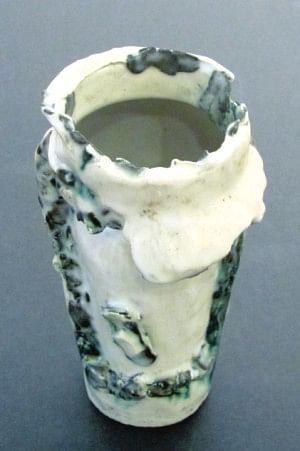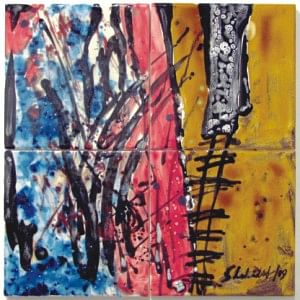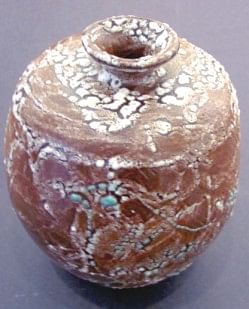|
Art
Ceramic creations from Cool Canada
Fayza Haq
 La Galerie of Alliance Française, when it reopened after Victory Day and Ashura, was agog with art lovers – mostly bourgeois – of all ages. The Ceramics exhibition was called “The presence of the suave”. Canadian High Commissioner Robert Mcdougall, and flamboyant, cheerful Akku Chowdhury of Liberation War Museum repute, added to the fanfare. Delicious snacks of French cuisine origin and beverages were in abundance. The artist whose works were on display, Syed Shahadat Hussain's, family and friends were there too, to lend him support. The artist– having studied in Canada, the UK and Japan– was confident and conscious of what he had to offer his countrymen. Like many other Bangladeshi artists, he does not forget his roots. His landscapes, portraits, cutesy cartoons and abstract creations were carefully hung on the suitably lit exhibition hall. Their muted colours and subtle lines were admirable. On a rectangular table in the centre were more ceramic displays of interest. They attracted professional artists like Fakhrul Islam, who is quite a connoisseur of fine arts, with a mind of his own. Can a display of ceramic bowls make waves? This one did. La Galerie of Alliance Française, when it reopened after Victory Day and Ashura, was agog with art lovers – mostly bourgeois – of all ages. The Ceramics exhibition was called “The presence of the suave”. Canadian High Commissioner Robert Mcdougall, and flamboyant, cheerful Akku Chowdhury of Liberation War Museum repute, added to the fanfare. Delicious snacks of French cuisine origin and beverages were in abundance. The artist whose works were on display, Syed Shahadat Hussain's, family and friends were there too, to lend him support. The artist– having studied in Canada, the UK and Japan– was confident and conscious of what he had to offer his countrymen. Like many other Bangladeshi artists, he does not forget his roots. His landscapes, portraits, cutesy cartoons and abstract creations were carefully hung on the suitably lit exhibition hall. Their muted colours and subtle lines were admirable. On a rectangular table in the centre were more ceramic displays of interest. They attracted professional artists like Fakhrul Islam, who is quite a connoisseur of fine arts, with a mind of his own. Can a display of ceramic bowls make waves? This one did.
Hussain believes that pleasing the critique is important. He says that it helps in the development of one's own maturity. “This bowing to the critique helps other artists as well. In the end it propagates more sensitive ideas,” says Hussain.
When asked if Bangladesh – which has its own history, that goes back to Mainamati, Paharpur and Mahastangarh – was lagging behind other developing countries, like the Far Eastern ones, he returns the query with a quick, adequate reply. He says that there were two reasons working behind the problems of Bangladesh. “We don't have particular clay companies here. We use clay from nature. We require clays of a better quality. Our ceramics uses imported clay. Other competitors, on the other hand, are very advanced. We must keep in mind that the people from the Far East have a very different culture and philosophy. Aesthetically too, their thought processes differ. Again, their materials are very different from the traditional pottery or ceramics of our country."

Talking about how our ceramics by Monno or Beximco compared to the table ware of the same price elsewhere in the world market, Hussain says that he is basically concerned with studio ceramics, which is quite different and not commercial ceramics. Talking about Monno, the artist mentions that this firm has recently opened its showroom in Canada, where he himself lives and works. He believes that this has a world quality and has promise. They have had an exhibition to introduce themselves in North America, and hopefully they will get a very good response, he adds.
Touching on how the best ceramics can do better in overseas competition, Hussain says that this will depend on the patronage of the Bangladesh government and embassies.
 Asked to compare the best porcelain or tableware, fitting the bourgeois budget in the Far East – like Korea, China and Japan–Hussain says that the porcelain for the Far Eastern countries are very related. The craftsmen of these countries have a long practicing history behind them. He says, “As they have developed China clay and China ceramics – beginning from China and moving on to Korea and Japan. I myself am practicing in Japanese Ceramics. I'm trying to combine the know-how of Japanese and Bangladeshi Ceramics. I believe this gives my work an individual character.” Asked to compare the best porcelain or tableware, fitting the bourgeois budget in the Far East – like Korea, China and Japan–Hussain says that the porcelain for the Far Eastern countries are very related. The craftsmen of these countries have a long practicing history behind them. He says, “As they have developed China clay and China ceramics – beginning from China and moving on to Korea and Japan. I myself am practicing in Japanese Ceramics. I'm trying to combine the know-how of Japanese and Bangladeshi Ceramics. I believe this gives my work an individual character.”
Asked to comment on his present display, Hussain says, I tried to bring in art works, which include realistic and abstract. When I work, I experiment as much as possible. I use different themes on the glazed tiles. I need to continue experimenting on materials and techniques. In the long run I hope to develop my own style. Speaking about the equipment that he uses, Hussain says that he has a kiln and turn wheel set up in his studio, where the raw material and glazed tiles are kept.
 The artist says that he has faced difficulties at the outset, but right now many doors are opened for him. In Bangladesh there were problems of finding raw material and kilns. Going to Rayerbazar or Savar for the baking with the objet d'art or carrying out one's research in Dhaka was not easy for any young student or fledgling artist. “Traffic jams were there even in my time. It was also expensive. You couldn't deliver your goods in time. The political backdrop was 'crazy' and certainly not conducive for me with the hartals mucking up the days. In Canada, I can work in peace, surrounded by nature.” The artist says that he has faced difficulties at the outset, but right now many doors are opened for him. In Bangladesh there were problems of finding raw material and kilns. Going to Rayerbazar or Savar for the baking with the objet d'art or carrying out one's research in Dhaka was not easy for any young student or fledgling artist. “Traffic jams were there even in my time. It was also expensive. You couldn't deliver your goods in time. The political backdrop was 'crazy' and certainly not conducive for me with the hartals mucking up the days. In Canada, I can work in peace, surrounded by nature.”
His backing since his student days were his mother, who was very progressive, and also his siblings. They provided him with raw materials and egged him on and his teachers like Mir Mustafa Ali, Maran Chand Pal, N Shamsul Islam Nizami and Abu Syed Talukdar. Adding humour to the conventional flow and repartee Hussain adds that when his first piece was sold in Dhaka, he was filled with the joy of the first sale. Hussain has figured in the pages of Bangladeshi and Canadian newspapers. He is an award-winning artist, whose works are in demand.
Copyright
(R) thedailystar.net 2010 |
| |
